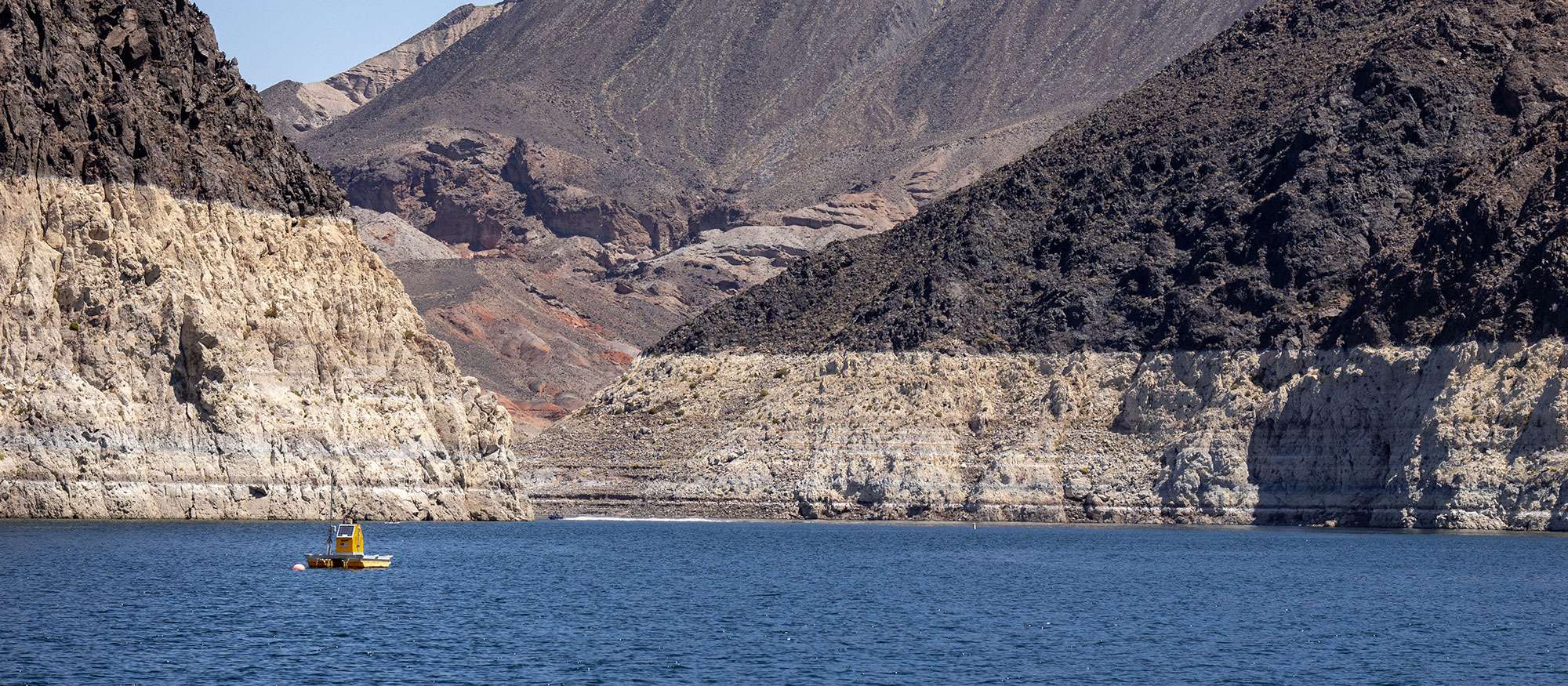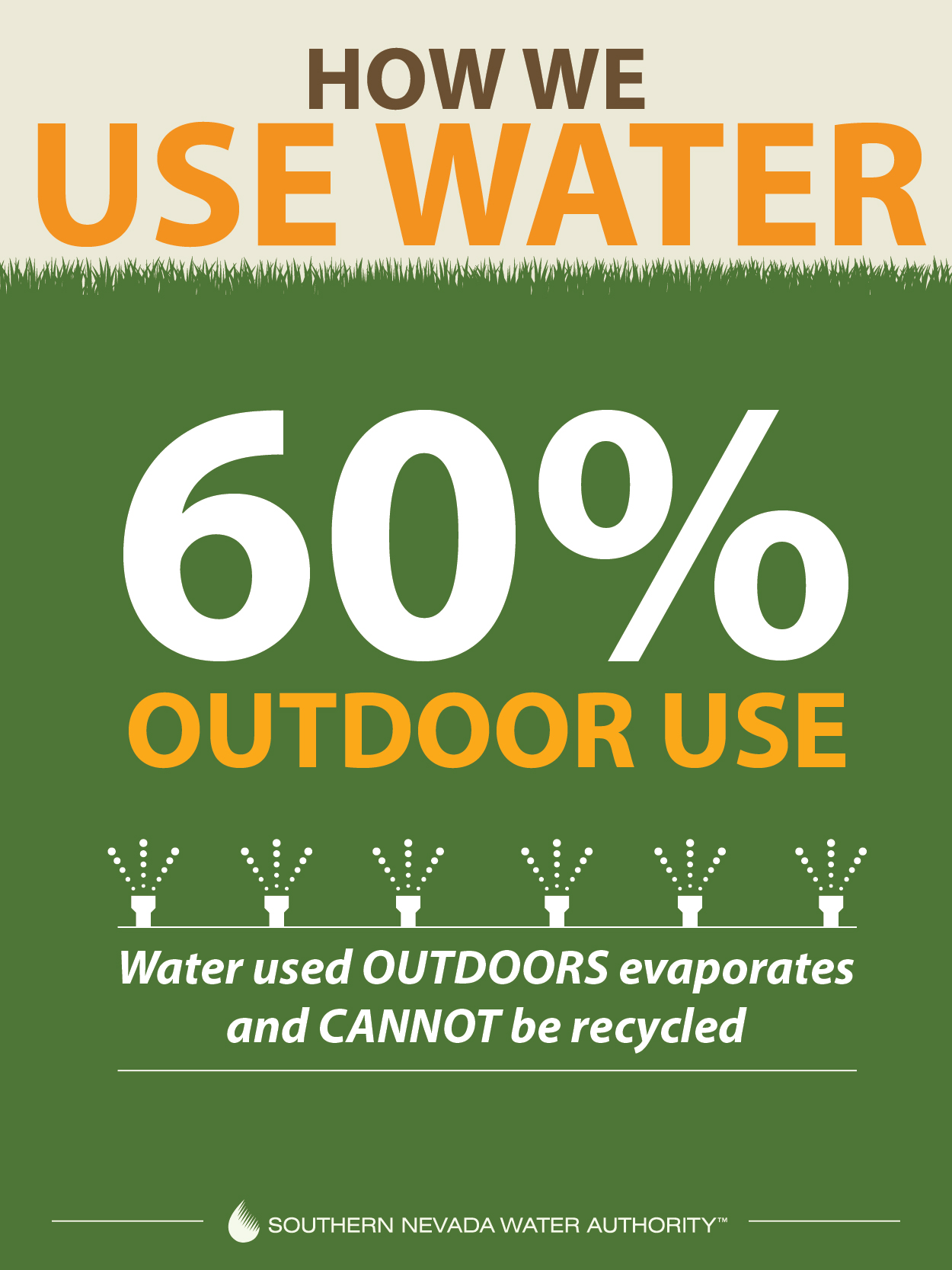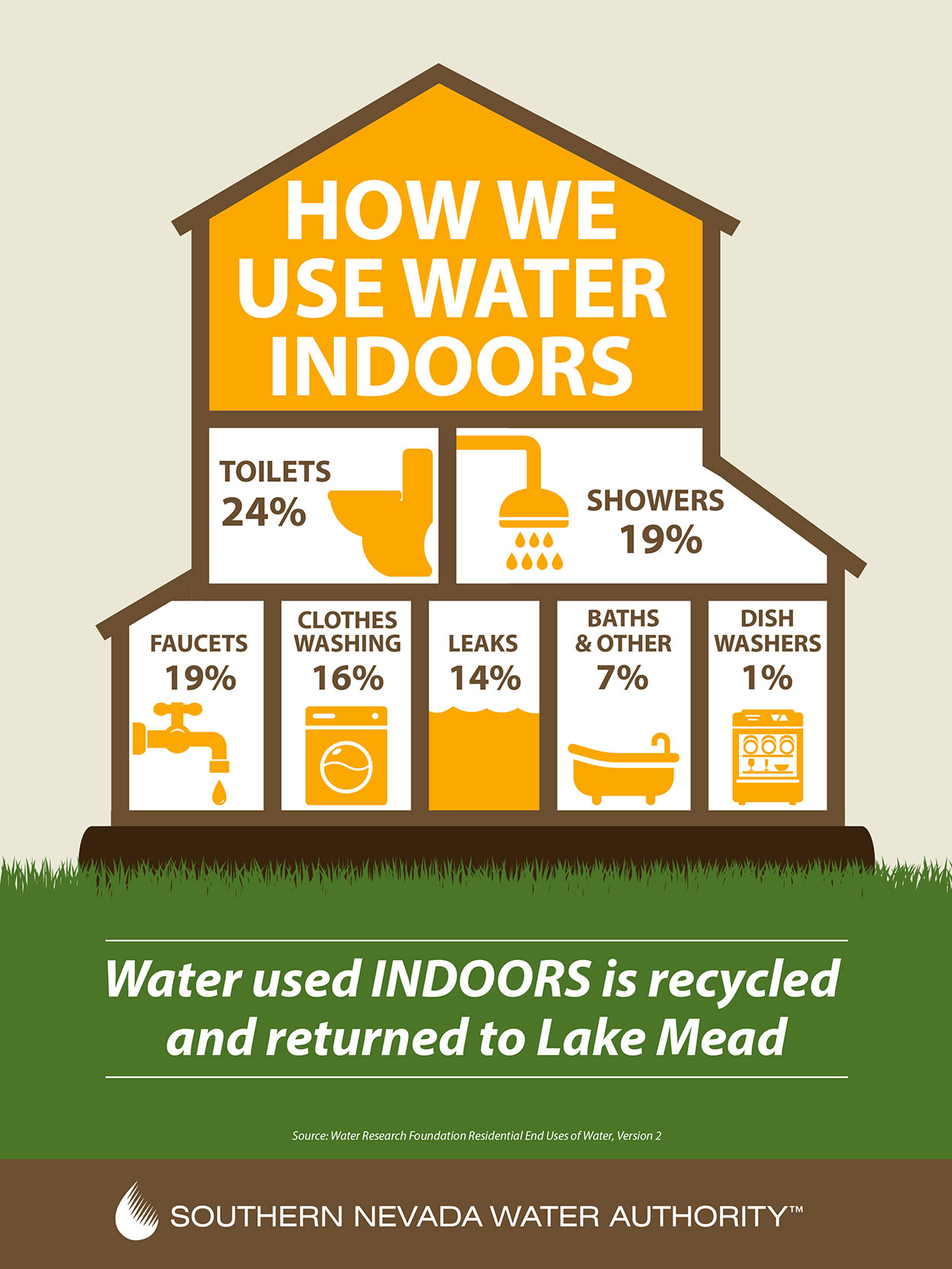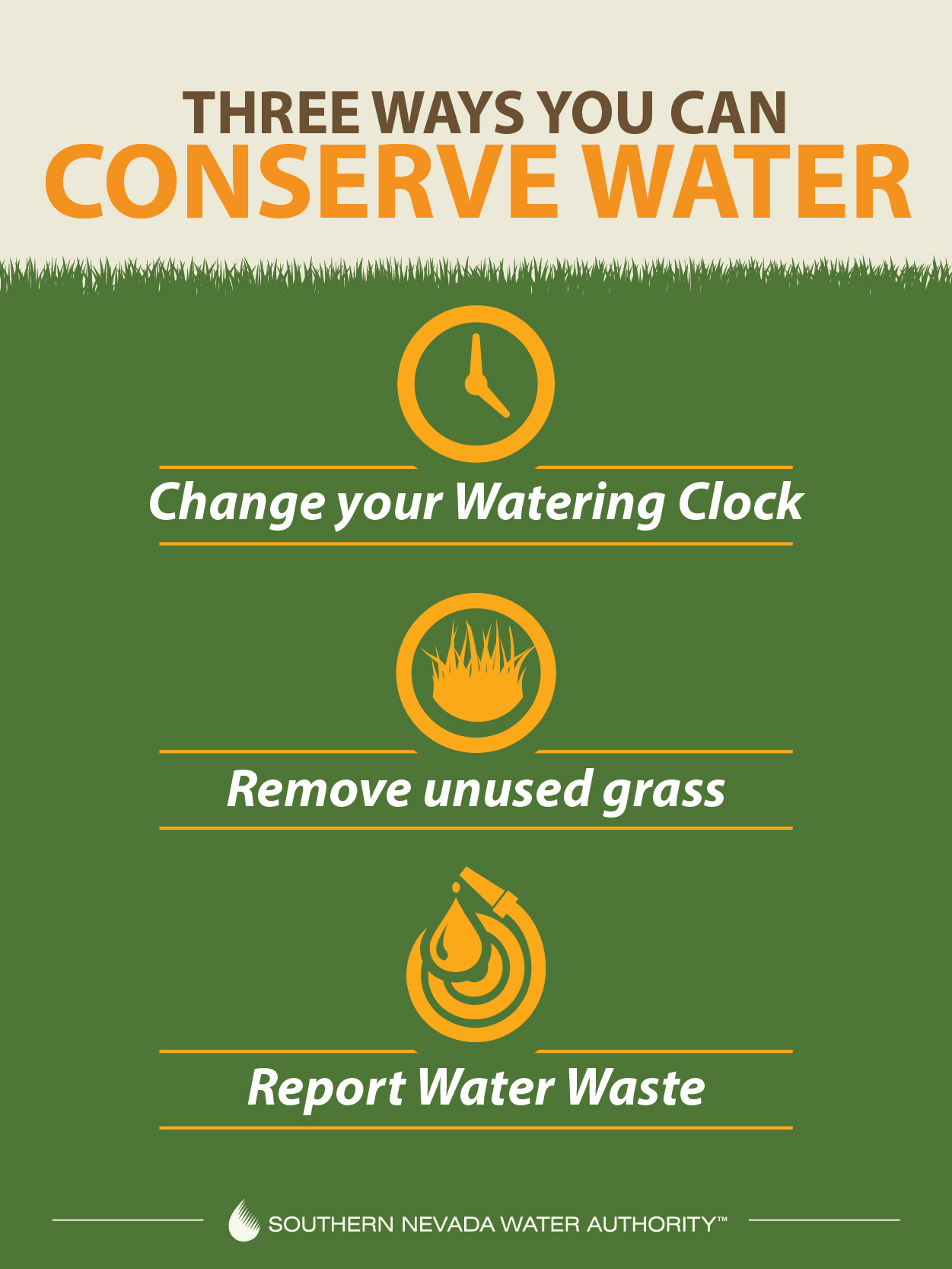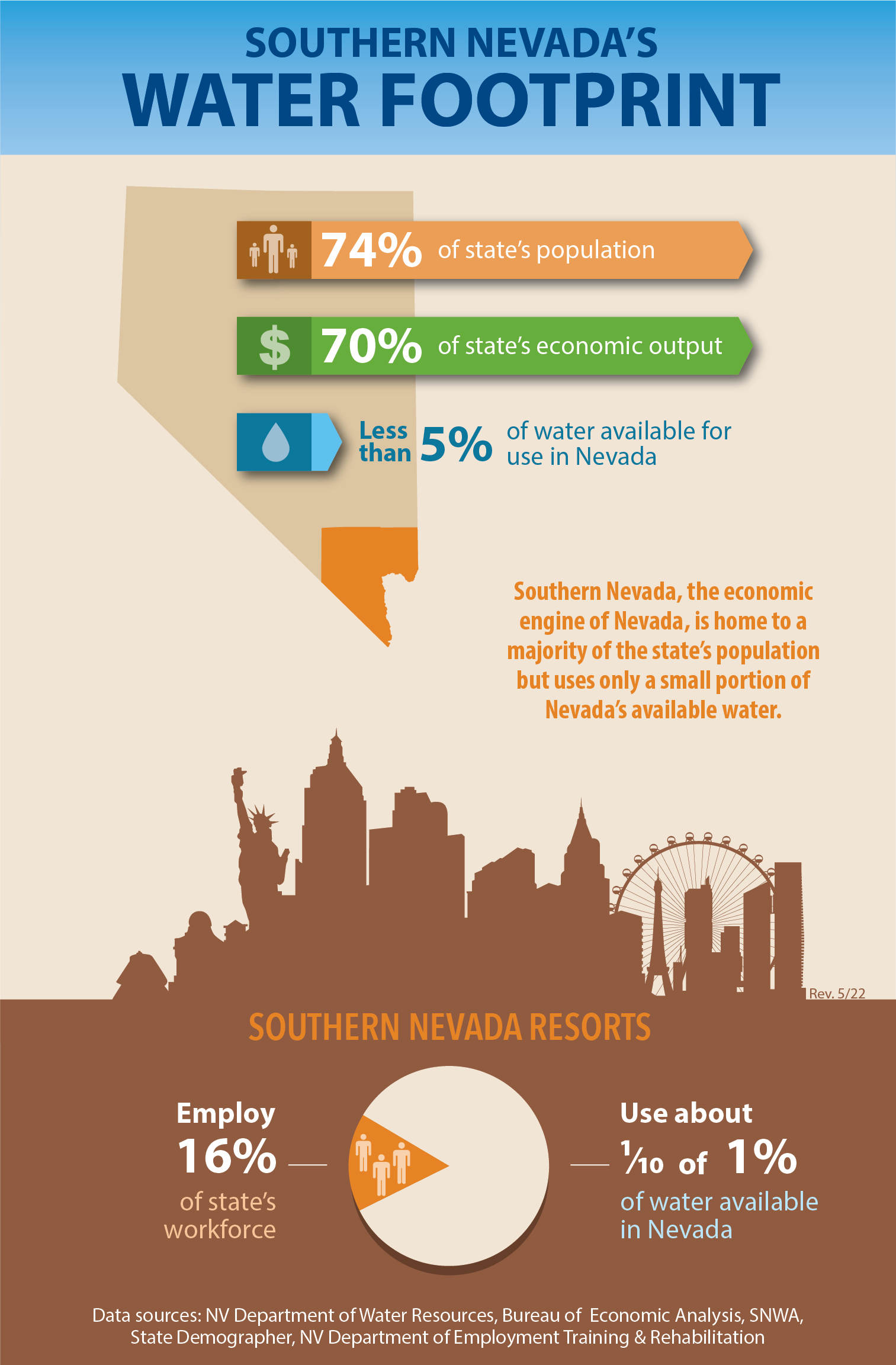The Colorado River system is facing the worst drought in the river basin's recorded history. The water level of Lake Mead, which serves as one of the river's primary water storage reservoirs, has dropped more than 150 feet since January 2000, and the federal government has issued a water shortage declaration on the Colorado River.
For more than 25 years, the Southern Nevada Water Authority has been taking actions to respond to the drought and prepare for potential water cuts.
From the development of new facilities such as the Low Lake Level Pumping Station and third drinking water intake, to water banking and system conservation initiatives, these efforts have reduced the potential for customer impacts. One of the SNWA's largest efforts is implementing aggressive conservation initiatives to reduce our community water use.
Planning for the future
For details on how we will meet Southern Nevada's water needs and strategies for continued water efficiency and conservation, view the plans linked below.
Program achievements
The Water Authority has developed and implemented one of the most comprehensive water conservation programs in the nation.
Conservation efforts have helped the community reduce its per capita water use by 55 percent between 2002 and 2024, even as the population increased by approximately 829,000 residents during that time.
Programs that have helped us achieve this accomplishment include:
- Water Smart Landscape Rebate Program - More than 241 million square feet of grass have been removed, saving 203 billion gallons of water since 1999.
- Water Efficient Technologies Program - Since 2001, participating businesses have saved more than 24 billion gallons of water through the program.
- Water Smart Homes - Nearly 17,000 homes were built via the program from 2005-2020, saving 14 billion gallons of water.
- Pool Cover Instant Rebate Coupon Program - More than 45,000 coupons were distributed before the program was retired in June 2020, saving an estimated 5.6 billion gallons of water.
For more information about the history of SNWA's conservation program, read the Joint Water Conservation Plan.
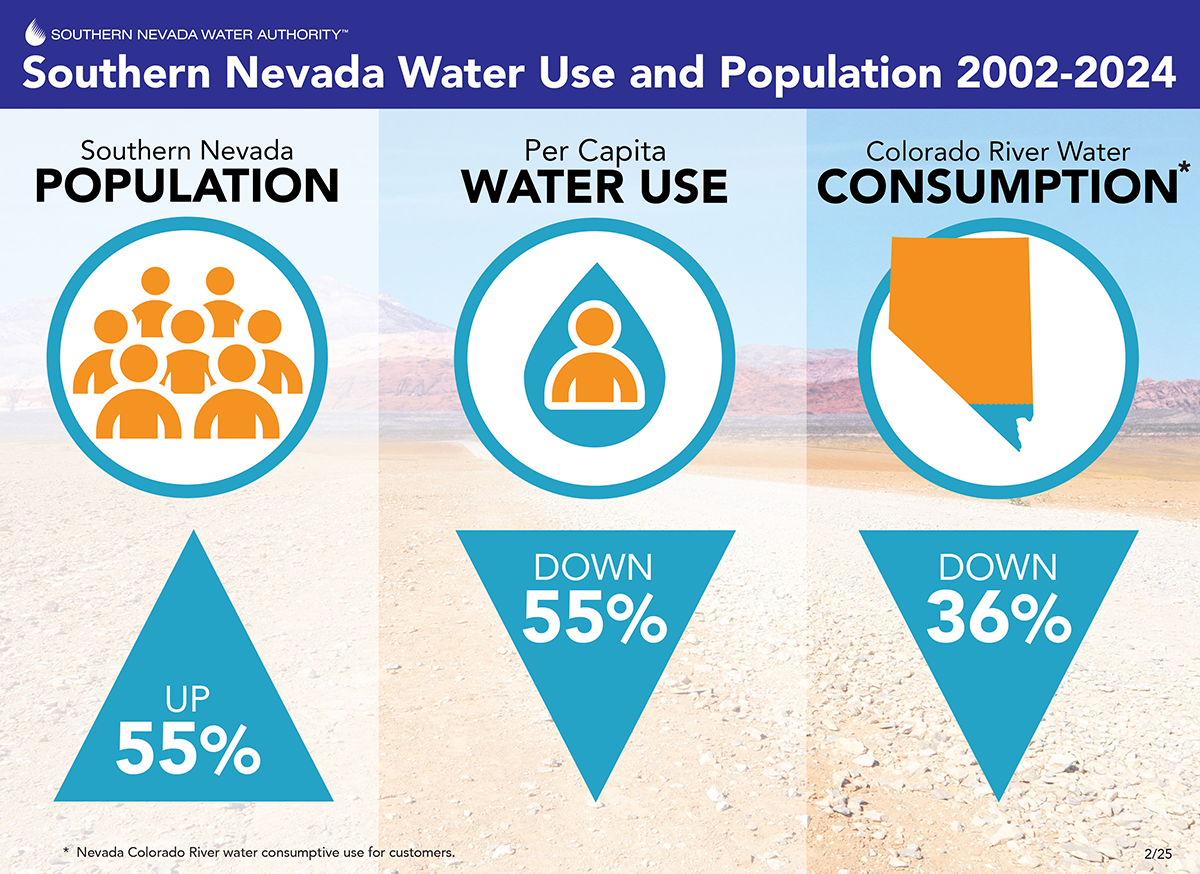
*Nevada Colorado River water consumptive use for customers.
New initiatives
Continued declines in Lake Mead's water level are expected as Southern Nevada experiences a permanent transition to a more arid future, the result of ongoing climate change. For this reason, additional efforts are needed to ensure a reliable long-term water supply for our community.
Our goal: Recognizing water conservation as a critical resource, the SNWA established a new conservation goal of 86 GPCD (gallons per capita per day) by 2035.
Several major new water efficiency measures have either been adopted or are being considered by the Water Authority:
We see what you see, less water at Lake Mead
Decades ago, the SNWA recognized the challenges our community could face as the Colorado River began delivering less water to Lake Mead due what is now being called a megadrought.
It acted quickly to ensure Las Vegas and Southern Nevada would have reliable access to water, even in a dead pool scenario.
Can we bring more water to Las Vegas?
From partnering with Southern California to exploring desalination in Mexico, SNWA is finding smart, cost-effective solutions to bring more water to Las Vegas.
Learn why massive projects like diverting water from the Mississippi River aren't practical, and how we're focusing on sustainable strategies.
The majority of Southern Nevada’s water is used outdoors. Most of that evaporates and cannot be returned to Lake Mead.
Nearly all the water we use indoors in Southern Nevada is treated and returned to Lake Mead. This recycled water earns us return-flow credits, which stretches our limited water supply.
For this reason, our conservation rebates and programs focus on reducing water use outdoors and we encourage Southern Nevadans to change their watering clocks, remove unused grass, and report water waste.
Southern Nevada contains 74% of the state's population and creates 70% the state's economic output, while using less than 5% of water available for use in Nevada. Southern Nevada resorts employ 16% of the state's workforce and only use about 1/10 of 1% of water available in Nevada.
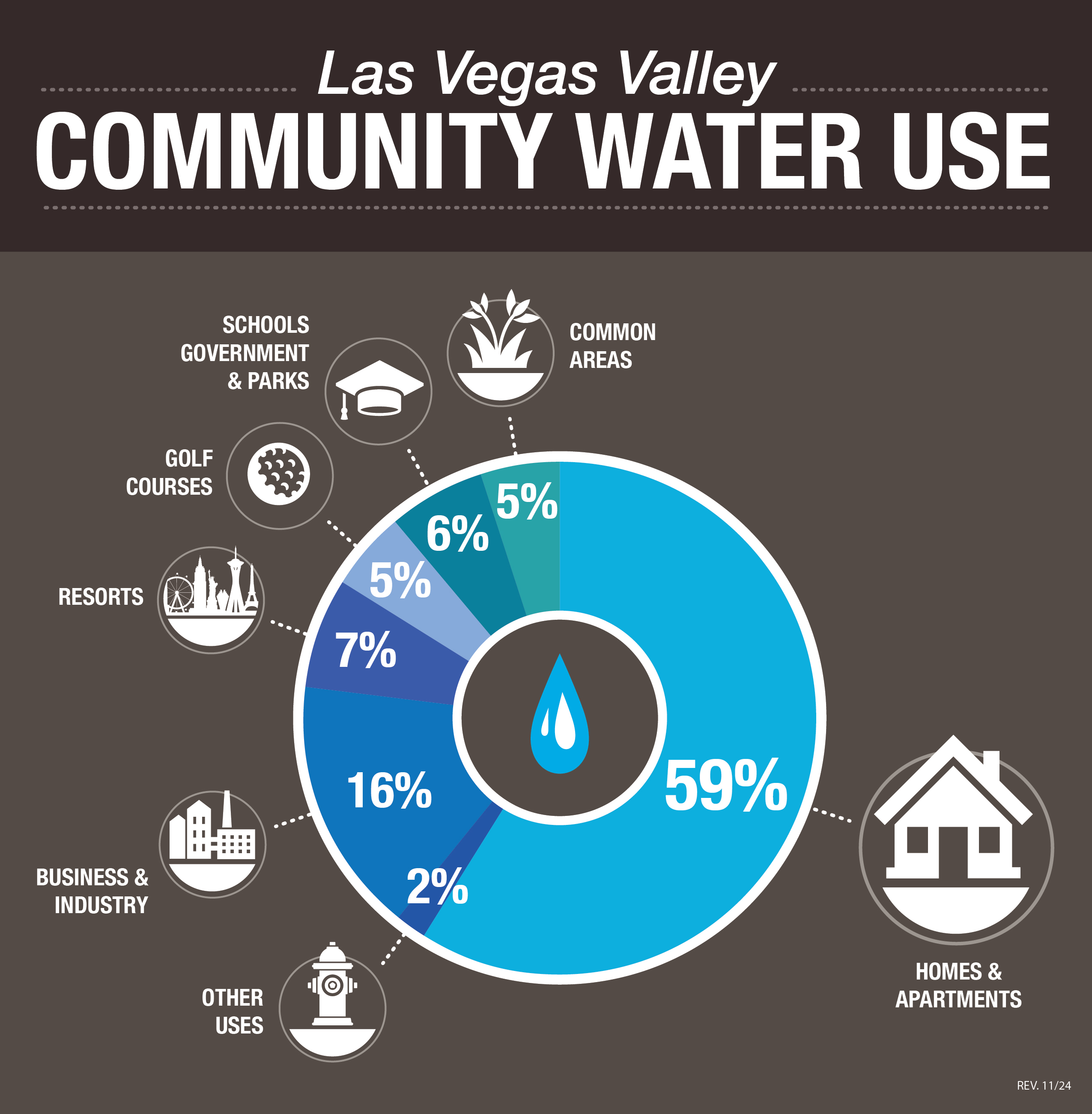
Homes and apartments make up nearly 60 percent of the community's water use, and residents have the biggest opportunity to help protect and conserve Southern Nevada's resources. However, every sector of our community has been required to make sacrifices in response to drought conditions and federal water cuts. Learn how all of Southern Nevada is working together on the path to water security.
Community water use by sector
💬 "Stop the building! Stop the resorts! Stop the golf courses! We don't have the water at Lake Mead!" 💬
Southern Nevada, we hear you call out specific sectors of the community for its water usage... but is it deserved? Learn more about how some particular industries use water from Lake Mead and why our water supply is secure, even as lake levels decline.
The residential sector — including single-family homes and multi-family apartments — makes up nearly 60 percent of Southern Nevada’s annual water use.
Because residents are the largest users of water, they also have the biggest opportunity to help protect and conserve the water supply for the community. The majority of water used by residents is from outdoor sources, like landscape irrigation. Water used outdoors evaporates, cannot be recycled, and counts against the community’s annual allotment of Colorado River water from the federal government.
The best way for residents to curb outdoor water use is to follow mandatory seasonal water restrictions and replace nonfunctional grass with drip-irrigated trees and plants through the Water Authority’s Water Smart Landscapes program.
- In 2004, development codes were updated to prohibit grass in the construction of new single-family residential front yards.
- In 2021, the installation of irrigated grass was prohibited in all new developments, including residential front and back yards.
- In 2022, the Southern Nevada Water Authority approved a resolution that limits new residential pools to a 600-square-foot surface area.
- Learn more about these and other conservation restrictions.
While water used indoors is recycled and returned to Lake Mead, residential users can reduce indoor water use and potentially save money on their water bill by finding and fixing household leaks and following other indoor conservation best practices.
▶️ Watch to learn more:
Resorts consume 7 percent of our community’s water supply — that’s the water that is only used once and not recycled.
Resorts are able to maintain such a small water footprint because nearly 100 percent of all water used indoors in Southern Nevada is recycled and returned to Lake Mead. That includes water used inside resorts and casinos in hotels rooms, restaurants, and other areas.
Many outdoor water features at resorts use nuisance groundwater and not a drop of our community's Colorado River water supply. Additionally, resorts are prohibited from installing new fountains and ornamental water features unless they are located entirely indoors (where the water gets recycled and returned to Lake Mead) or are supplied exclusively by privately-owned water rights (like the Bellagio fountains, which is supplied by brackish groundwater from a private well owned by MGM Resorts).
In addition, new resorts are required to submit water efficiency plans, ensuring efficient water management and a commitment to water conservation. Viewed from the state level, the resort sector uses less than one-tenth of one percent of Nevada's water supply, while employing about 16 percent of the state's workforce.
▶️ Watch to learn more:
It is a common misperception that golf courses use large amounts of the community’s water. In reality, golf courses use 5 percent of our area's water. Golf courses use a combination of potable, raw, reclaimed and recycled water to help extend the community's supply.
New golf courses are prohibited in Southern Nevada and several important actions have been taken to reduce golf course water use over the past two decades. First, every course in Southern Nevada is subject to strict water budgets, and high penalties are levied for exceeding them—up to nine times the top-tier water rate. In 2023, golf course water budgets were reduced even further.
Some local golf courses utilize warm season turf to save water and will paint the turf green when it goes dormant. Many local courses have also participated in the Southern Nevada Water Authority’s program for converting grass to desert landscape, even using GPS-equipped golf balls to determine areas of courses that never saw play and removing turf from those areas outside the fairways and on driving ranges. They also use weather stations coupled with central irrigation computers to adjust irrigation run times daily based on weather conditions.
A law enacted by the Nevada Legislature in 2021 will prohibit the use of Colorado River water delivered by Water Authority member agencies to irrigate nonfunctional grass at various properties, including golf courses, beginning in 2027.
A water savings of 55 gallons per square foot is realized for areas converted from turfgrass to drip-irrigated desert landscapes. Since 1999, 30 local golf courses have removed more than 900 acres of grass.
The commercial business and industrial sector accounts for 16 percent of Southern Nevada’s water use.
The Southern Nevada Water Authority offers a variety of programs and resources to help businesses save water, including the Water Smart Landscapes program for converting grass to desert landscaping; the Water Efficient Technologies program for installing water-efficient devices and technologies; and the Water Upon Request program for restaurants. Learn more about conservation resources and incentive programs for businesses.
Because evaporative cooling mechanisms are highly water intensive and are Southern Nevada's second largest consumptive use of water, the Southern Nevada Water Authority Board of Directors voted to pass a resolution supporting a moratorium on the installation and use of evaporative cooling mechanisms in new commercial and industrial buildings in the Las Vegas Valley.
Additionally, a law enacted by the Nevada Legislature will prohibit the use of Colorado River water delivered by Water Authority member agencies to irrigate nonfunctional grass at commercial properties, beginning in 2027.
Businesses are generally subject to the same water waste ordinances and watering restrictions as residents. If you see water waste at a business or commercial property, please report it to the water utility for that area.
Common areas use 6 percent of Southern Nevada’s water supply.
A law enacted by the Nevada Legislature in 2021 will prohibit the use of Colorado River water delivered by Water Authority member agencies to irrigate nonfunctional grass in many of these areas, beginning in 2027.
Examples include streetscape turf (grass located along streets, sidewalks, driveways, parking lots, medians, and roundabouts); frontage, courtyard, interior and building-adjacent turf (grass in front of, between, behind or otherwise adjacent to buildings); and certain HOA-managed landscape areas.
▶️ Watch to learn more: New law bans useless grass in Southern Nevada
Schools, government, and parks make up 6 percent of Southern Nevada’s water use.
Schools and government properties are subject to the proposed moratorium on evaporative cooling systems, and must comply with the Nevada state law that prohibits the use of Colorado River water delivered by Water Authority member agencies to irrigate nonfunctional grass, beginning in 2027.
Although athletic fields and playgrounds are considered functional turf areas under the law and schools are allowed to have grass in these areas under specific conditions, many local schools are prioritizing water efficiency by participating in the Water Smart Landscapes program to replace some grass with desert landscaping and artificial turf.
Specific exemptions to the seasonal watering schedule may be approved for public use facilities like schools and parks if they meet certain conditions like programmable areas for recreational events or being unable to comply with all watering restrictions due to extraordinary public demand. As such, schools and parks fall under a Community Use Turf Area (CURTA) exemption with local water service providers and are allowed to follow alternate seasonal watering schedules on different days and times to reduce the impact on members of the community and to ensure all parts of the property are being adequately watered. If you do see water waste at a park or school in Southern Nevada, including a malfunctioning irrigation system or water flowing into the street, please report the violation to the water utility for that city.
Other uses — including water used for construction, dust control and fire hydrant meter use — account for 2 percent of Southern Nevada’s water use.
Clark County has very strict regulations and requirements associated with dust control to reduce PM-10 (inhalable particulate matter with diameters that are generally 10 micrometers and smaller). These requirements are very important in helping maintain our local air quality, and construction companies have an obligation to mitigate dust on their sites.
Water used on construction sites usually is paid for and metered from fire hydrants. If you suspect unauthorized water connections from hydrants, pipelines, or other water systems, please report suspected water theft activity.
